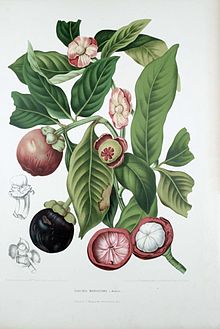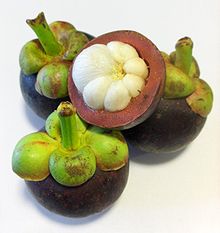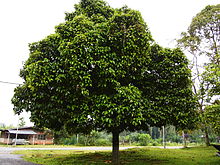- Purple mangosteen
-
- "Mangosteen" redirects here. This may also refer to the entire genus Garcinia.
Purple Mangosteen 
Illustration from "Fleurs, Fruits et Feuillages Choisis de l'Ile de Java" 1863-1864 by Berthe Hoola van Nooten (Pieter De Pannemaeker lithographer) Scientific classification Kingdom: Plantae (unranked): Angiosperms (unranked): Eudicots (unranked): Rosids Order: Malpighiales Family: Clusiaceae Genus: Garcinia Species: G. mangostana Binomial name Garcinia mangostana
L.The purple mangosteen (Garcinia mangostana), colloquially known simply as mangosteen, is a tropical evergreen tree believed to have originated in the Sunda Islands and the Moluccas of Indonesia. The tree grows from 7 to 25 m (20–80 ft) tall. The fruit of the mangosteen is sweet and tangy, juicy, and somewhat fibrous, with an inedible, deep reddish purple-colored rind (exocarp) when ripe.[1] In each fruit, the fragrant edible flesh that surrounds each seed is botanically endocarp, i.e., the inner layer of the ovary.[2]
The purple mangosteen belongs to the same genus as the other, less widely known, mangosteens, such as the button mangosteen (G. prainiana) or the charichuelo (G. madruno).
A description of mangosteen was included in the Species Plantarum by Linnaeus in 1753.
Contents
Maturation of the exocarp and edible aril
The juvenile mangosteen fruit, which does not require fertilisation to form (see agamospermy), first appears as pale green or almost white in the shade of the canopy. As the fruit enlarges over the next two to three months, the exocarp colour deepens to darker green. During this period, the fruit increases in size until its exocarp is 6–8 centimetres in outside diameter, remaining hard until a final, abrupt ripening stage.
The subsurface chemistry of the mangosteen exocarp comprises an array of polyphenols including xanthones and tannins that assure astringency which discourages infestation by insects, fungi, plant viruses, bacteria and animal predation while the fruit is immature. Colour changes and softening of the exocarp are natural processes of ripening that indicates the fruit can be eaten and the seeds have finished developing.[3]
Mangosteen produces a recalcitrant seed and must be kept moist to remain viable until germination. Mangosteen seeds are nucellar in origin and not the result of fertilisation; they germinate as soon as they are removed from the fruit and die quickly if allowed to dry.[4]
Once the developing mangosteen fruit has stopped expanding, chlorophyll synthesis slows as the next colour phase begins. Initially streaked with red, the exocarp pigmentation transitions from green to red to dark purple, indicating a final ripening stage. This entire process takes place over a period of ten days as the edible quality of the fruit peaks.
Over the days following the removal from the tree, the exocarp hardens to an extent depending upon postharvest handling and ambient storage conditions, especially relative humidity levels. If the ambient humidity is high, exocarp hardening may take a week or longer when the aril quality is peaking and excellent for consumption. However, after several additional days of storage, especially if unrefrigerated, the arils inside the fruit might spoil without any obvious external indications. Using the hardness of the rind as an indicator of freshness for the first two weeks following harvest is therefore unreliable because the rind does not accurately reveal the interior condition of the arils. If the exocarp is soft and yielding as it is when ripe and fresh from the tree, the fruit is usually good.
The edible endocarp of the mangosteen is botanically defined as an aril with the same shape and size as a tangerine 4–6 centimetres in diameter, but is white. The circle of wedge-shaped arils contains 4–8 segments, the larger ones harbouring apomictic seeds that are unpalatable unless roasted.
Often described as a subtle delicacy, the arils bear an exceptionally mild aroma, quantitatively having about 1/400th of the chemical constituents of fragrant fruits, explaining its relative mildness.[5] The main volatile components having caramel, grass and butter notes as part of the mangosteen fragrance are hexyl acetate, hexenol and α-copaene.
On the bottom of the exocarp, raised ridges (remnants of the stigma), arranged like spokes of a wheel, correspond to the number of aril sections.[6] Mangosteens reach fruit-bearing in as little as 5–6 years, but more typically require 8–10 years.[7]
Nutrient and phytochemical content
Mangosteen,
canned, syrup packNutritional value per 100 g (3.5 oz) Energy 305 kJ (73 kcal) Carbohydrates 18 g - Sugars ? g - Dietary fibre 1.8 g Fat 0.6 g Protein 0.4 g Water 81 g Percentages are relative to US recommendations for adults.
Source: USDA Nutrient DatabaseThe aril is the part of the fruit which contains the flavor; when analyzed specifically for its nutrient content, the mangosteen aril is absent of important nutrient content.[8]
Some mangosteen juice products contain whole fruit purée or polyphenols extracted from the inedible exocarp (rind) as a formulation strategy to add phytochemical value. The resulting juice has purple colour and astringency derived from exocarp pigments, including xanthonoids under study for potential disease amelioration effects.[9] The potential health benefits of xanthones were debated in a four-part series in 2009.[10][11][12][13]
Other authors proposed alpha-mangostin, a xanthone, could stimulate apoptosis in leukæmia cells in vitro.[14]
Furthermore, a possible adverse effect may occur from chronic consumption of mangosteen juice containing xanthones. A 2008 medical case report described a patient with severe acidosis, possibly attributable to a year of daily use (to lose weight, dose not described) of mangosteen juice infused with tannins.[15]
Uses in folk medicine
Various parts of the plant have a history of use in folk medicine, mostly in Southeast Asia.[16] It is reputed to have possible anti-inflammatory properties, and may have been used to treat skin infections or wounds, dysentery or urinary tract infections.[16] Research on the phytochemistry of the plant is still inadequate to assure the safety or scientific certainty of any of these effects.[16]
Legend, geographic origins and culinary applications
There is a legend about Queen Victoria offering a reward of 100 pounds sterling to anyone who could deliver to her the fresh fruit.[17] Although this legend can be traced to a 1930 publication by the fruit explorer, David Fairchild, it is not substantiated by any known historical document, yet is probably responsible for the uncommon designation of mangosteen as the "Queen of Fruit".[17]
In his publication, "Hortus Veitchii", James Herbert Veitch says he visited Java in 1892, "to eat the Mangosteen. It is necessary to eat the Mangosteen grown within three or four degrees of latitude of the equator to realize at all the attractive and curious properties of this fruit."[18]
A tropical tree, the mangosteen must be grown in consistently warm conditions, as exposure to temperatures below 0°C (32°F) for prolonged periods will generally kill a mature plant. They are known to recover from brief cold spells rather well, often with damage only to young growth. Experienced horticulturists have grown this species outdoors, and brought them to fruit in extreme South Florida.
Due to restrictions on imports, mangosteen is not readily available in certain countries. Although available in Australia, for example, they are still rare in the produce sections of grocery stores in North America and Europe. Following export from its natural growing regions in Southeast Asia, the fresh fruit may be available seasonally in some local markets like those of Chinatowns. Mangosteen and its related products, such as juices and nutritional supplements, are legally imported into the United States, which had an import ban until 2007.
Mangosteens are available canned and frozen in Western countries. Without fumigation or irradiation as fresh fruit, mangosteens have historically been illegal for importation in commercial volumes into the United States due to fears that they harbour the Asian fruit fly, which would endanger U.S. crops. This situation, however, officially changed on 23 July 2007, when irradiated imports from Thailand were allowed upon USDA approval of irradiation, packing and shipping techniques.[19] Freeze-dried and dehydrated mangosteen arils can also be found.
Since 2006, private small volume orders for fruits grown in Puerto Rico were sold to American gourmet restaurants who serve the aril pieces as a delicacy dessert.[20] Due to the shape and feel of the fruits, they were promoted in parts of the US as 'fruit grenades'. Beginning in 2007 for the first time, fresh mangosteens were sold from speciality produce stores in New York City for as high as $45 per pound,[21] but, during 2009 and 2010, wider availability and lower prices have become common in the United States and Canada.
Before ripening, the mangosteen shell is fibrous and firm, but becomes soft and easy to pry open when the fruit ripens. To open a mangosteen, the shell is usually scored first with a knife; one holds the fruit in both hands, prying gently along the score with the thumbs until the rind cracks. It is then easy to pull the halves apart along the crack and remove the fruit. Occasionally, during peeling of ripe fruits, the purple exocarp juice may stain skin or fabric.
References
- ^ "Mangosteen: Sweet, Tangy, Delicious". Exotic Fruit For Health. 26 August 2011. http://www.exoticfruitx.com/2011/08/mangosteen-sweet-tangy-delicious/. Retrieved 22 October 2011.
- ^ Mabberley, D.J. 1997. The plant book: A portable dictionary of the vascular plants. Cambridge University Press, Cambridge.
- ^ Plant Pigments for Colour and Nutrition
- ^ Mangosteen seed information
- ^ MacLeod AJ, Pieris NM. Volatile flavour components of mangosteen, Garcinia mangostana. Phytochemistry 21:117–9, 1982
- ^ Mangosteen photographs showing external characteristics (mangosteen.com)
- ^ Mangosteen growing characteristics
- ^ Mangosteen nutrient information
- ^ Jung HA, Su BN, Keller WJ, Mehta RG, Kinghorn AD (March 2006). "Antioxidant xanthones from the pericarp of Garcinia mangostana (Mangosteen)". Journal of Agricultural and Food Chemistry 54 (6): 2077–82. doi:10.1021/jf052649z. PMID 16536578.
- ^ Crown I (2009). "Beyond the Mangosteen: A Future Full of Colour". Engredea (April 1, 2009). http://newhope360.com/beverage/beyond-mangosteen-future-full-color. Retrieved 1-4-2010.
- ^ Morton DA (2009). "Mangostana - Commentary on the Mangosteen". Engredea (16th April, 2009). http://newhope360.com/g-mangostana-commentary-mangosteen. Retrieved 1-4-2010.
- ^ Crown I (2009). "A Rebuttal on Mangosteen". Engredea (5th May, 2009). http://newhope360.com/rebuttal-mangosteen. Retrieved 1-4-2010.
- ^ Gross P, Crown I (2009). "The Mangosteen Controversy". Engredea (May 21, 2009). http://newhope360.com/antioxidant/mangosteen-controversy. Retrieved 1-4-2010.
- ^ Matsumoto K, Akao Y, Yi H, et al. (November 2004). "Preferential target is mitochondria in alpha-mangostin-induced apoptosis in human leukaemia HL60 cells". Bio-organic & Medicinal Chemistry 12 (22): 5799–806. doi:10.1016/j.bmc.2004.08.034. PMID 15498656.
- ^ Wong LP, Klemmer PJ (May 2008). "Severe lactic acidosis associated with juice of the mangosteen fruit Garcinia mangostana". American Journal of Kidney Diseases 51 (5): 829–33. doi:10.1053/j.ajkd.2007.12.043. PMID 18436094.
- ^ a b c Obolskiy, D., I. Pischel, N. Siriwatanametanon, M. Heinrich, 2009. Garcinia mangostana L. (mangosteen): A phytochemical and pharmacological review. Phytotherapy Research 23(8): 1047–1065. DOI: 10.1002/ptr.2730, abstract
- ^ a b The history and folklore of the mangosteen
- ^ Veitch, James Herbert (2006). Hortus Veitchii. Caradoc Doy. p. 89. ISBN 0-9553515-0-2.
- ^ Karp, David (27 June, 2007). "Welcome at the Border: Thai Fruits, Once Banned". The New York Times. http://www.nytimes.com/2007/06/27/dining/27frui.html. Retrieved 22 May, 2010.
- ^ Karp, David (9 August, 2006). "Forbidden? Not the Mangosteen". The New York Times. http://www.nytimes.com/2006/08/09/dining/09mang.html?ex=1312776000&en=0d1a76f2087e406d&ei=5088&partner=rssnyt&emc=rss.. Retrieved 22 May, 2010.
- ^ Karp, David (8 August, 2007). "Mangosteens Arrive, but Be Prepared to Pay". The New York Times. http://www.nytimes.com/2007/08/08/dining/08mang.html. Retrieved 22 May, 2010.
External links
- MontosoGardens.com — Garcinia mangostana (Clusi aceae)
- Morton, J. 1987. Mangosteen. p. 301–304. In: Fruits of warm climates. Julia F. Morton, Miami, FL.
- "Mangosteen price too low: farmers", The Nation, July 31, 2007
- Tropical sweetness: harnessing the elusive mangosteen, P. Temple-West, Medill Reports-Washington, DC, March 5, 2008
- Brent A. Bauer, M.D.. "MayoClinic.com questions:Mangosteen juice: can it relieve arthritis pain?". http://www.mayoclinic.com/health/mangosteen/AN01197.
Categories:- Fruit
- Garcinia
- Tropical fruit
- Flora of Indonesia
- Vietnamese ingredients
- Lao ingredients
- Thai ingredients
- Fruits originating in Asia
Wikimedia Foundation. 2010.


